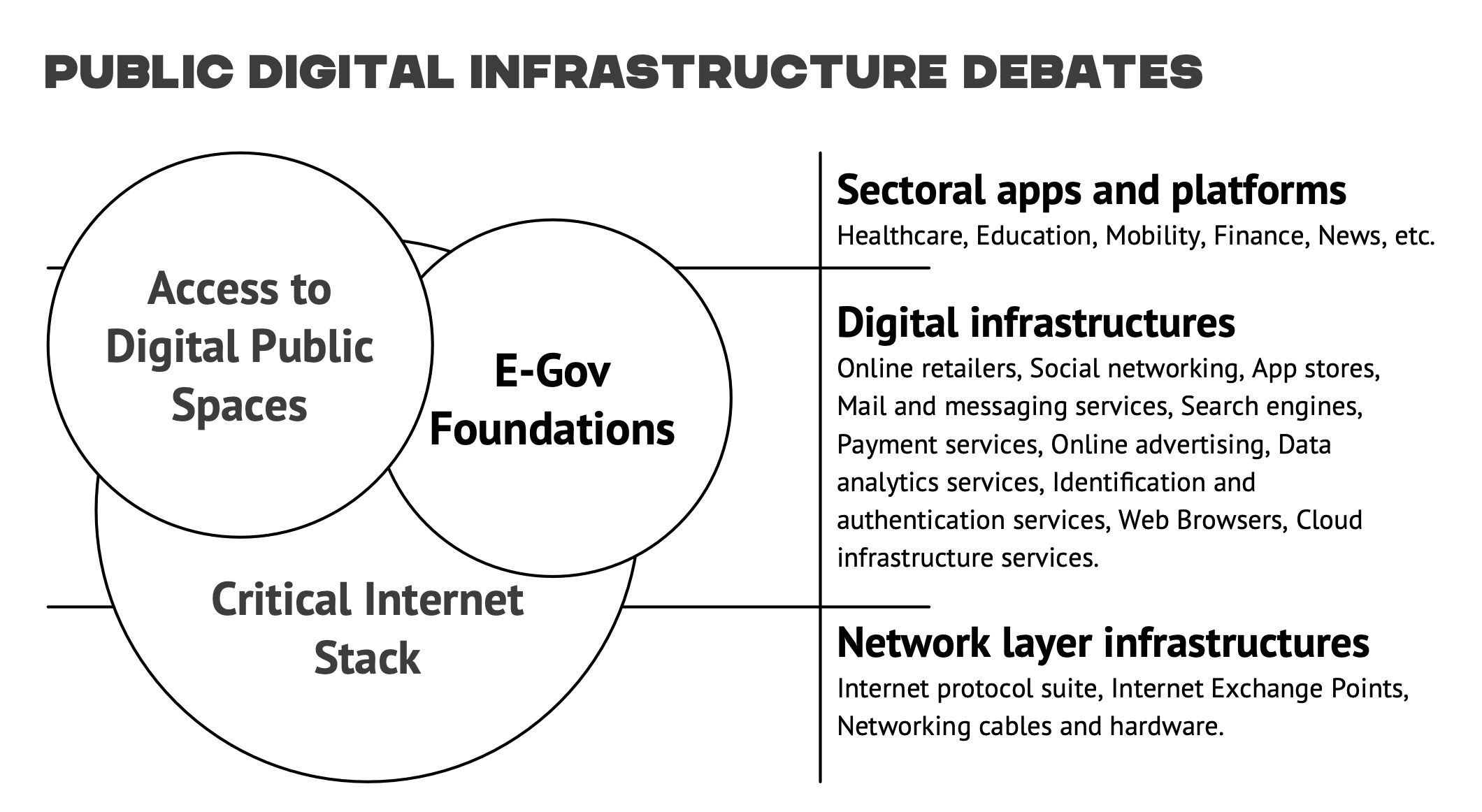Signs of progress: Digital Public Infrastructure is gaining traction
The discussion about digital public infrastructure is gaining traction, with actors ranging from the Indian government to the United Nations Development Programme (UNDP) or private sector giants like Huawei, Amazon Web Services, and Mastercard endorsing its importance. It’s seen as a solution to numerous contemporary issues, from enhancing digital sovereignty to improving connectivity and interoperability among digital services and products. This trend reflects a growing acknowledgment of digital infrastructure’s pivotal role in addressing both a vast array of socio-economic development challenges and the current concentration of digital markets.
The shift towards viewing our digital environment through an infrastructure analogy, rather than likening data to oil or online computing services to clouds, is a positive one. This perspective presents digital services as comparable to roads—accessible pathways for various purposes determined by individual users. Moreover, it highlights the tangible reality of our digital world, urging us to prioritize not just innovation but also collective and sustainable maintenance. As highlighted by Fran Tonkiss, infrastructures “represent the most basic elements of collective consumption (and collective disposal) organizing social, economic, and environmental lives which are lived, at least partly, in common.”
Similarly to Ethan Zuckermann’s, our approach prioritizes the most critical “infrastructures that let us engage in public and civic life in digital spaces.” We believe that these digital infrastructures should not be public by accident, for instance, because of the decision by a private stakeholder to make it an open resource but intentionally public. This entails designing them for the public interest and ensuring public participation: making participation public (transparent) and open to different actors (plural and decentralized).
To underscore these principles, we use the term “Public Digital Infrastructure” (PDI) instead of “Digital Public Infrastructure” (DPI), putting the notion of public first.
What should be covered by the Public Digital Infrastructure debate?
The historical notion that only telecommunications networks and the physical layers of the internet constitute infrastructure is increasingly being challenged. First, it is being challenged by the overall “dynamic extension of infrastructure as a concept that includes both ‘hard’ (technical) artifacts and systems and intangible ‘soft’ (social) networks.” Secondly, the competition between private online services has paradoxically led to an expansion of digital infrastructure: the winner-takes-all dynamics of social media caused the emergence of essential facilities underlying digital public spaces, resulting in a centralized and platform-ruled digital environment, in contrast to the protocol-based network of networks that characterizes the internet. In addition, as noted in the recent European Commission White Paper on Europe’s Digital Infrastructure Needs, connectivity infrastructure is continually converging with computing power and software components, leading to the merging of offerings into “infrastructure as a service” business models. These trends contribute to a policy debate about the public nature of digital infrastructures. This debate usually covers three different fields: foundational e-government services, critical services of the internet stack, and services essential for access to digital public spaces.

Adapted from Van Dijck, J. (2021). Seeing the forest for the trees: Visualizing platformization and its governance. New Media & Society, 23(9), 2801-2819.()
The concept of digital public infrastructure has been spearheaded by India and draws from its experience with the development of digital identity, but also e-commerce, and payment systems. Aadhaar (which means foundation in Hindi) is the name of the unique identification number that has been developed by the Government of India starting in 2010. It is the world’s largest biometric ID system. Because of its openness, it allows sectoral applications to be easily built on top of it. It has, therefore, become a foundational system, allowing citizens to access both public and private services. It has also been subject to criticism for the security and privacy risks associated with a centralized architecture. The Indian model for DPI, called the India Stack, is based on a set of open application programming interfaces (APIs) that are considered “government-owned, non-competing goods (…) made available at low costs.”
Another example of digital public infrastructures is Estonia’s X-Road, which is an open-source government data exchange system. Both the Indian and the Estonian initiatives address common challenges faced by governments globally; their role in accelerating countries’ development has been recognized by the G20 and UNDP. The potential for scalability and adaptation of these solutions has even garnered significant interest from various stakeholders, including development organizations, consultancy firms, and digital vendors, eager to leverage these experiences to deliver new services to governments.
An alternative vision of digital public infrastructure has arisen as a result of the global Covid-19 pandemic and growing geopolitical tensions, which have led to a technological battle, information warfare, and the militarization of digital infrastructures. This vision focuses on “critical infrastructures” from a sovereignty standpoint, focusing again on the resilience of physical layers but also on the concerns about state surveillance and cyberattacks. It has further strengthened the case for public support for the free and open source software ecosystem on which our societies and economies depend. It also spurred the much-needed introduction of initiatives such as the German Sovereign Tech Fund, which provides funding for open digital infrastructure. As opposed to the classic reflex, which leads states to turn in on themselves and focus on their biggest national industrial players, such an approach to reducing dependencies and vulnerabilities is defined by generating a more decentralized digital landscape.
Although it’s commendable that governments are endorsing open source solutions and cooperating on shared technological foundations when creating digital public services, our understanding of Public Digital Infrastructure should transcend critical internet and e-government services. It requires a much more fundamental reflection on the systems that are already essential for the provision of society-wide functions. Recent debates in India over the power of Google’s Play Store have demonstrated the need to further expand the original approach focused on e-gov applications.
With the Digital Services Act and the Digital Markets Act, the European Union has already chosen to regulate digital services that have become gatekeepers. This approach primarily aims to address market dominance by big tech from a competition standpoint. However, we argue that even under strong regulation, private entities are inadequate providers of Public Digital Infrastructure, particularly because they can’t manage Digital Public Spaces. Market dynamics foster centralization, leading to numerous adverse effects such as wealth transfer and dependencies. Specifically, social media platforms, whose business models are based on surveillance capitalism, fail to offer healthy digital public spaces that uphold our fundamental digital rights. Therefore governments need to take more responsibility in the maintenance of the underlying technological stack for the digital public sphere—to build a shared public infrastructure that prioritizes public values, democracy, and accessibility.
The meaning of “public” in Public Digital Infrastructures
As expressed by the World Bank, governments should have “a primary role and responsibility in deciding whether and how digital public infrastructure is provided in the interests of the broader society and economy.” This means that not everything with an open code or public access can be considered Public Digital Infrastructure. Public Digital Infrastructure in fact also implies that the good in question has a collective impact that requires collective maintenance and shared responsibility. The question remains, however, if governments should operate, strongly regulate or simply partner with the private sector for the provision of this infrastructure. The current uses of the term digital public infrastructure seem to remain too vague to enable real change. While definitions such as the one provided by the UN Digital Public Goods Alliance are great in scoping what should fall within the debate (“solutions and systems that enable the effective provision of essential society-wide functions and services in the public and private sectors”), broader input from citizens, academics and institutions are needed to clarify what is entailed by this denomination, especially in terms of governance.
We do not believe that governments should be the sole operators of Public Digital Infrastructure. This is primarily due to the inherent risks associated with centralized architectures when managed by States. It demonstrates the need for more participatory governance and operationalization. Moreover, the current lack of capacity to build and maintain digital services within public administrations can only be addressed by working with external communities.
Our definition of Public Digital Infrastructure, therefore, implies an infrastructure in the public interest but also with public participation: participation made public (transparent) and open to different actors (plural and decentralized).
These principles are similar to those suggested by Ethan Zuckermann, emphasizing traits like “publicly spirited, but diverse in funding, plural in purpose, participatory in governance, publicly auditable and reviewable.”
At Open Future, we indeed believe that for infrastructure to be truly public, it must be both open and controlled by its users, workers, and maintainers. A large variety of proven models for building digital resources governed by community-based access and sharing rules exist and are usually called the Digital Commons. They seem to be the best mechanism to provide Public Digital Infrastructure: ensuring plurality and, therefore, avoiding a unique and centralized model.
Unlike Zuckerman, however, who primarily focuses on a small vs. big (tech) analysis, our approach is firmly rooted in a distinction between public and for-profit entities. This contrast appears to stem from differing operational contexts: community-based civic engagement in the US versus a longstanding tradition of public service provision in the EU. Although we advocate for small, community-driven initiatives emerging from the Digital Commons, we recognize the necessity of public intervention to enable non-profit alternatives to scale and compete effectively. As outlined in our previous work, our goal is to facilitate the integration of multiple smaller interoperable networks into a public communications space facilitated by a European Public Digital Infrastructure Fund. Historical European models for investing in media landscapes to ensure plurality offer valuable precedents in this respect.
Shaping a European Approach to Public Digital Infrastructure
It’s encouraging to witness governments worldwide increasingly discussing digital public infrastructure, which holds numerous benefits such as enhancing openness and collaboration around e-government services, encouraging state interventions in foundational services that everyone needs access to, and safeguarding sovereignty over critical infrastructures. However, there are concerning trends where this discourse may be misinterpreted in three critical ways: (1) narrowing the focus solely on e-government services, overlooking the pivotal role of the current private infrastructures enabling access to our digital public spaces; (2) neglecting plurality and favoring government-owned centralized solutions; and (3) prioritizing private interests and ownership over public welfare, exemplified by global private entities co-opting the term DPI. We advocate for an understanding of digital infrastructures where the “public” comes first, emphasizing transparent, inclusive, and decentralized design principles.





